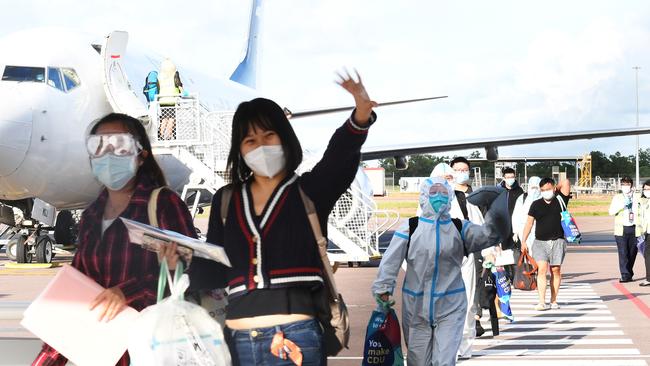Overseas student lockout adds to universities’ domestic woes

The past year has already seen a remarkable boom in global student mobility come to a screeching halt. This was only the prelude to a multiyear upheaval. Indeed, a confluence of factors will lead to more lean years ahead for Australia’s universities: the prolonged lockout of international students, an unsympathetic government, a souring Australia-China diplomatic relationship, and dogged efforts by other Anglosphere nations to court new students.
No new international students are likely to reach Australian shores for the next 12 months. Several states, led by NSW, are working on “safe corridors” that could see the arrival of a few thousand foreign students later this year, with the costs of quarantine to be self-funded or subsidised by universities. However, these schemes will prioritise the return of continuing students. They will do little to mitigate the larger problem: a precipitous drop-off in new commencements.
READ MORE: Border policy ‘not smart’ | China could stymie students
While students partway through an Australian degree have a strong incentive to finish their studies, even if it means watching grainy Zoom lectures from overseas, surveys of education agents suggest that new applicants are now likely to preference Canada, the UK and the US ahead of Australia. The appeal of an on-campus experience endures, even in these socially distanced times.

For Australian universities, the revenue writedowns from lost tuition fees will cascade into future years. The financial shock is proportionately larger for Australia than it is most other advanced nations. Before the pandemic, over a quarter of students enrolled at tertiary level in Australia, and over half at master’s level, were from overseas. This compares to just 6 per cent and 13 per cent, respectively, for the OECD average.
To top it all off, tertiary providers must contend with recent changes to domestic funding arrangements. The government’s Job-ready Graduates Package creates more university places for young Australians, but it also reduces the revenue that universities earn on a per-student basis. Vice-chancellors had been hoping for new lifelines in the May budget, such as another top-up of the Research Support Program, but none have been forthcoming apart from some regulatory fee relief. Federal expenditure on higher education will drop 8.3 per cent in real terms next financial year. The taxpayer-funded “rivers of gold” that a former education minister once pilloried are drying up.
So what’s next? Here are a few predictions. First, Australia will lose global market share. The US State Department recently tweaked its visa policy to permit students from China and various other countries entry for courses from August 2021. Ministers in Canada and the UK have tied international education to broader national policy on immigration and post-pandemic rebuilding of their economies.
Secondly, most universities can – perhaps counterintuitively – scrape through the crisis. While the revenue downturn will be painful, an assertive response by chief financial officers has helped to protect their finances. Universities have slashed headcount, renegotiated employment contracts, frozen new capital investment, closed unviable campuses or courses, tapped reserves or contingency funds, sold assets, and, in some cases, raised new debt. Already, several institutions have outperformed pessimistic forecasts from a year ago.
University leaders face a delicate balancing act. They will call on staff for further parsimony in 2021, to defend against another year of revenue squeeze. But as the pandemic drags on, resistance from staff and students will grow. A recent course-cutting proposal at Swinburne University of Technology, for instance, triggered a rare vote of no confidence in management.
Thirdly (and related to the second point), prospects for substantial government aid appear slim. But there are several novel mechanisms for the public sector to provide a little financial support outside of direct grants. For example, several universities in Darwin, Launceston and Perth are benefiting from “city deals” that bring together all three tiers of government to fund new CBD campuses. In some states, universities have access to concessional loan facilities or guarantee schemes from their state government treasuries. And last year saw Charles Darwin University, CQUniversity, and James Cook University enter into new loan agreements backed by the Northern Australia Infrastructure Facility.
Fourthly, there is now a real risk that escalating Sino-Australian tensions will spill over into education. In February, China’s Ministry of Education issued a fresh warning (after one in June 2020) regarding the personal safety of its students in Australia. It’s not difficult to envisage a scenario in which, say, Canberra exercises its new foreign relations veto powers to shut down university-hosted Confucius Institutes, provoking fresh reprisals. China is by far the largest country of origin for international students enrolled at Australian universities, accounting for about 39 per cent. Beijing has used unofficial student sanctions as a geoeconomic tool in past disputes with South Korea and Taiwan.
Fifthly, and to conclude on a more positive note, campuses across the country are springing back to life. Demand from domestic school leavers is strong. And an improving economic backdrop is buoying markets, which will help those universities fortunate enough to have large investment portfolios.
Martin Foo is an associate director at S & P Global Ratings



Projections in last week’s federal budget that Australia’s hard border will remain in place until mid-2022 add further gloom for universities across the country.